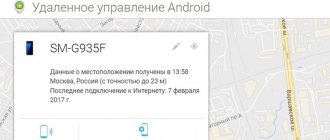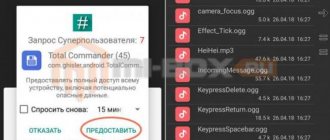Last week, Xiaomi, during the presentation of the Redmi Y2 smartphone in India (Redmi S2 in other regions), announced the release of the global beta version of MIUI 10. At the event, the Chinese technology giant presented the official list of devices that will be able to update to the new generation of firmware in June. Today, June 16, Xiaomi announced the availability of MIUI 10 Global Beta for the first six smartphone models.
The best Telegram channel about technology (possibly)
How to update MIUI via three dots?
“Three dots” are symbols that open up additional options in the “System Update” menu. In order to update without waiting for an over-the-air update, we need to download the required MIUI firmware. You can find them in this section.
Be careful, you can only upgrade the current version through the Update application:
- China – China
- Global – Global
- EU - EU
- RU - RU
When upgrading the version, the data is preserved; if you roll back, the data will be deleted.
You can't update like this:
- China – Global
- China – custom
- Global – China
- Global – custom
- Custom – China
- Custom – Global
- Russian to global
- European into Russian, etc.
Which versions currently support the update?
The list of smartphones that can be updated to the latest version consists of fifty models. These include devices that went on sale this year; devices from Mi8 Lite to Mi 9T Pro; Mi Mix 2s, 3; Mi Max 3; Pocophone F1; Redmi Note 9S and 8 Pro. In earlier models of the Redmi Note series, only closed beta test participants can download Android 10.
By the time the 11th version of the OS is released, owners of the above gadgets will also be able to update. The company promises to provide the opportunity to update the Poco X2, its Pro version, by the end of the year; Redmi Note 8 and 8T.
How to find out your MIUI firmware?
Currently, the following types of firmware for Xiaomi are relevant in Russia:
- Global (global, mi) - for example, PCG MI XM;
- European (eu) - for example, QFA EU XM;
- Russian (ru) - for example, PED RU XM.
The MIUI version can be found in the settings of your smartphone (in this case, global):
What's new compared to MIUI 11
There are no significant changes in functionality in Miyuai 12. Almost all innovations relate to graphics, animation, applications and privacy of personal data. Let's take a closer look:
- Smooth animation with beautiful effects . It appears when switching between vertical and horizontal mode, as well as when opening programs and tabs.
- Changed design . All icons, settings menu and notification shade have been redrawn.
- Dynamic font . Letters can be scaled by adjusting their size and thickness. This should work not only with hieroglyphs, but also with Latin and Cyrillic alphabet.
- Dark Mode 2. . Dark mode is now supported in all system and third-party applications. After its activation, the image gradually darkens, rather than just turning on a black background.
- Super Wallpaper . The firmware introduced animated space wallpapers that move from the lock screen to the desktop. You can also customize an animated weather forecast: all natural changes will be displayed on the screen in the form of screensavers.
- Changed Notes , Tasks , Calculator, and Camera . The programs have received many improvements both in design and functionality.
- New themes in Always on Display . Users are offered a huge selection of dials, pictures and designs for the AOD.
- Convenient organization of important phone data . Information such as storage capacity, free/used memory space, smartphone characteristics is displayed in the form of graphs.
We talked more about the latest features in the news about the presentation of MIUI 12.
Instructions for updating via “three dots”
In our example, we used MIUI 9.2 Global Stable firmware for Redmi 3S.
Download the update to your computer (or directly to your smartphone, if you have enough memory) and move it to your phone or memory card. In our case, the MIUI firmware zip file ended up in the root folder of the smartphone (you can download it to any folder).
Before updating, make sure your smartphone is charged!
Open on Xiaomi “Settings” - “About system” at the bottom there is a button “System update”
“Update” application will open , click on the image of the three dots on the right and select the “Select firmware file” .
If there is no such menu, click on the screen (logo) 10 times and it should appear.
Through Explorer, specify the file with the firmware and click “OK” , after selecting it, parsing the update file will begin immediately.
Next, the smartphone will require a reboot and will continue to update the MIUI shell.
If an error window appears when selecting the firmware, it means that the versions of the current MIUI and the one being installed do not match, or the update file is “broken,” check that it was transferred to the smartphone correctly. Also, the update will not start if the firmware version is provided only for testers (demo version). In this case, you should wait for your update.
What's new in MIUI 11
The full list of new features was described in the news about the announcement of MIUI 11 China and MIUI 11 Global. Here we briefly mention the main changes:
- Always on display . The mode received new dynamic screensavers and elements. You can display your own recordings on the screen. AOD is only relevant for smartphones with AMOLED displays.
- Sounds of nature . They can be set as ringtones, notifications and alarms. There is the sound of fire, water, rain, leaves, birdsong.
Sounds of nature
- Dark theme . Special design of the system in black tones, designed to save battery power. Can be used in individual applications (for example, in Explorer). The selection of standard themes and wallpapers has also expanded.
Dark mode
- Mint Keyboard and MilanPro font . Targets more than 25 languages, especially suitable for Latin, hieroglyphs and Hindi. The new font automatically adjusts to the size of the letters, making the text easier to read.
- Parental control . You can monitor your child's activities on the phone using the Google Family Link app. Namely: control access to Google services, remotely track your phone, set time limits.
Parental control
- Quick answers . Quick replies can be configured for notifications from instant messengers and social networks. This is a good solution for busy users.
Quick answers
- Speeding up games . The Game Turbo tool frees up space on your device and speeds up apps in real time.
Speeding up games
Feature comparison with MIUI 10
Now let’s compare the previous shell of Miui 10 with Miui 11, highlighting the main points:
- The system launcher hasn't changed much. In MIUI 11, the icons have been redrawn. They also look larger compared to MIUI 10.
Launcher MIUI 10 vs MIUI 11
- The settings menu is designed in a minimalist style. No unnecessary details.
Settings menu MIUI 10 vs MIUI 11
- The update to MIUI 11 brought new items such as Digital Wellbeing and Special Features .
- The MIUI 11 firmware has smoother animation, fixed system bugs and errors + updated Android security system.
How to install miui 10 via Fastboot mode?
This flashing procedure is a somewhat complicated operation to update the OS. To carry it out, you need MiFlash (an auxiliary special program) connected to the computer. For the operation to be successful, an unlocked bootloader is required. We have already given a detailed description of the entire flashing process. Based on this, it will not be difficult for you to perform all the necessary actions without disrupting the operation of the OS.
Now let’s summarize everything that was said earlier:
- disable driver digital signature verification (this applies to later modifications of Windows);
- install special MIUI ROM Flashing software for flashing firmware on smartphones and tablets of this company;
- remove the blockade from the bootloader;
- download the firmware suitable for your device from a trusted source (you will find the link to the site in the article above);
- switch the smartphone to Fastboot mode;
- connect to a computer;
- flash the firmware using your Mi account.
Redmi 5 Plus firmware on MIUI 10 with Android 8.1.0
In continuation of the news that firmware with the MIUI 10 shell is available for 21 Xiaomi smartphones, we are publishing for you a short instruction on flashing the Redmi 5 Plus smartphone to the MIUI 10 Global 8.7.12 Beta version.
Before we begin describing the process of flashing this smartphone, we note that:
YOU DO ALL ACTIONS FOR FLASHING YOUR SMARTPHONE AT YOUR OWN RISK
SMARTPHONE REQUIREMENTS:
- Unlocked bootloader;
- Custom recovery (TWRP).
If any of the requirements are not met, then installation of this firmware version is impossible .
DOWNLOADING THE FIRMWARE:
You can download the latest firmware from the official MIUI website or from the w3bsit3-dns.com website* . At the time of writing, version 8.7.12 is available for Redmi 5 Plus, which includes not only a transition to the MIUI 10 shell, but also an update to the Android version to 8.1.0 (Oreo). * to download from the 4PDA website you must be a registered user, otherwise you will receive an error.
PREPARING YOUR SMARTPHONE FOR UPDATE:
Before you start flashing your smartphone, WE STRONGLY RECOMMEND that you make a backup of the system and user data. You can back up your current system directly to TWRP.
Titanium Backup application will help you save copies of the necessary programs (root rights are required). You just need to transfer music, videos, photos, various documents, etc. to an installed SD card or flash drive connected via OTG to the USB connector of your smartphone.
SMARTPHONE FIRMWARE:
After completing the first three steps of the instructions, you can begin updating the firmware. The firmware downloaded from the link in step 2 must be placed on a memory card or USB flash drive. You should not copy it to the main memory of your smartphone, since the system partition will be formatted before the update (all information will be completely deleted). It is possible not to format the system partition, but in order to completely get rid of residual files of the old system and get the cleanest possible firmware, it is better to do this. After installing the new system, the amount of free permanent memory will be greater, due to the fact that it will be completely cleared of garbage and other files.
Consider the option of installing firmware from an SD card. To do this, you need to restart your smartphone and go into custom recovery. To do this, when you turn on the smartphone, you need to hold the volume up “+” key until the TWRP picture appears. Next, when the menu appears, you need to clear the data in the device’s memory. To do this we need the “Wipe” menu item. Having entered it, click “Advanced Wipe”
Check the boxes as in the third screenshot * and drag the slider at the bottom of the screen from left to right to start the process. * if you do not plan to completely clear the internal memory of your smartphone, then you need to uncheck the “Internal Storage” item.
At the end of the process, return to the main menu and go to the “Install” item. Click “Select Storage” and select the SD card (where the previously downloaded archive with the firmware is located) and click “OK”.
The contents of the map will be displayed, where you need to find and click on the required firmware. In the window that opens, check the “Reboot after installation is complete” box. This will allow you not to wait for the smartphone firmware process to finish before rebooting the smartphone. It will reboot automatically when the installation is complete. By swiping from left to right at the bottom of the screen, we start the installation of the selected firmware.
The window that opens will display the current process * , after which the smartphone will reboot. The first launch of a newly installed system takes much longer than usual; you will have to be patient and wait for the MIUI 10 welcome window. After which you can proceed with the standard initial system settings. * If the installation process fails with an error, reboot your smartphone. No boot will occur since the system partition is empty. You need to reboot your smartphone into TWRP (press and hold the power button and volume up until the smartphone reboots). After that, release the power button and wait for the custom recovery to start. Run the firmware installation process again.
WHAT CHANGED AFTER INSTALLING MIUI 10
Even during the initial setup, you will see differences in the appearance of the new shell. The interface has been largely redesigned. The main differences are worth noting:
1. The appearance of the quick settings panel has changed. The interface uses large round icons, the active functions of which are highlighted in blue.
The sorting of available functions has also been redesigned.
2. The brightness adjustment slider has become wider, making it easier to hit with your finger.
3. New look for the notification panel. It's now possible to hide an extra panel to display more notifications.
4. New volume control. Now the volume sliders are positioned vertically.
5. New preview of apps running in the background, which improves the usability of a full-screen smartphone. The manager presents an overview of the latest applications in a vertical format. The list can be scrolled up or down.
6. The functionality and the possibility of additional settings for Bluetooth devices in “Developer Mode” have increased significantly.
You can find a complete list of changes and innovations in the MIUI 10 shell at the link below.
MIUI 10. What's new? Which smartphones will receive the update?
GENERAL IMPRESSIONS OF MIUI 10 SHELL
While using the smartphone as the main device for a week after flashing, no glitches, freezes, spontaneous reboots or other negative aspects were noticed. The system is quite stable, the speed of the interface and the smartphone as a whole is at the proper level. Considering that this is a beta version and no one is immune from the occurrence of various errors at the stage of its testing and modifications, MIUI showed itself quite worthy. The developer, in any case, before releasing the final version of the firmware, will identify all minor defects and correct them, and then the stability of the system will become even higher, although, we repeat, we did not find any shortcomings in the work.
The improved system for working with on-screen gestures deserves special attention. Although the functionality has not changed, and there is no reason why, it has become much more convenient to work using gestures. All responses to a particular action have become clearer, and the number of false positives has decreased significantly. If you are already accustomed to this rather convenient function, then when you switch to MIUI 10, you most likely will not want to return to on-screen buttons.
During testing of the firmware, as expected for the weekly version, an update to MIUI 10 8.7.19 arrived. The designation 8.7.19 is nothing more than the release date of July 19, 2021. The firmware version, the installation of which we discussed in this manual, was dated July 12. As it is not difficult to notice, the update actually arrives once a week (with an interval of 7 days), the next update should be expected on the 26th.
The list of changes when moving to version 8.7.19 cannot be called outstanding. The manufacturer noted that system stability has been improved and performance has been optimized.
After all, the absence of any serious improvements indicates that the system is already quite stable and the wait for the release of the final build will not be long.
CONCLUSION
MIUI 10 is definitely no worse than MIUI 9. The redesigned interface is much more convenient. Of course, you need to get used to it, but after working with it, you understand that this is really so. Also, do not forget that with the shell update, the Android version was also updated. And this is a huge plus, which brings with it stability, higher speed, energy efficiency and many other pleasant aspects that have been improved in Oreo.
Buy a smartphone in the Rumikom store HOW TO BUY AT RUMIKOM WITH A DISCOUNT?
Why do you need an update via 3 points?
The fact is that new software versions, even for the same Xiaomi model, are not released simultaneously. A phone owner in Moscow may receive the update much later than a user from Novosibirsk.
This is due to the redistribution of load on the company’s servers. If all users start downloading software from the official website at the same time, it may crash and no one will be able to update. Therefore, if you did not wait for the coveted notification, check for an updated version yourself. After that, all you have to do is download the archive to your device and manually reflash it.
You can clearly see the entire process of flashing the device through three points from the overview video:
Using this technique, owners of Xiaomi smartphones can easily reflash their device without unlocking the bootloader. If you select the correct software version, all information saved on the phone will be saved. And the whole process will take no more than an hour.











